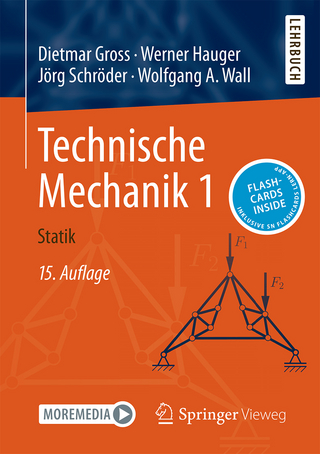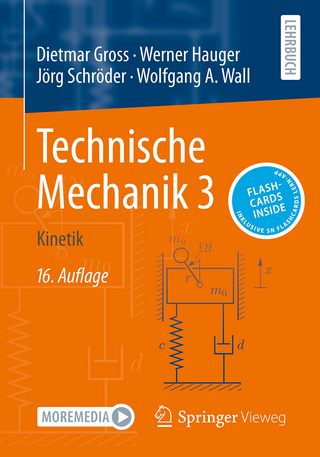
Internal Combustion Engines
John Wiley & Sons Inc (Verlag)
9781119454502 (ISBN)
Internal Combustion Engines: Applied Thermosciences, Fourth Edition combines foundational thermal-fluid sciences with engineering analysis techniques for modeling and predicting the performance of internal combustion engines.
This new 4th edition includes brand new material on:
New engine technologies and concepts
Effects of engine speed on performance and emissions
Fluid mechanics of intake and exhaust flow in engines
Turbocharger and supercharger performance analysis
Chemical kinetic modeling, reaction mechanisms, and emissions
Advanced combustion processes including low temperature combustion
Piston, ring and journal bearing friction analysis
The 4th Edition expands on the combined analytical and numerical approaches used successfully in previous editions. Students and engineers are provided with several new tools for applying the fundamental principles of thermodynamics, fluid mechanics, and heat transfer to internal combustion engines.
Each chapter includes MATLAB programs and examples showing how to perform detailed engineering computations. The chapters also have an increased number of homework problems with which the reader can gauge their progress and retention. All the software is ‘open source’ so that readers can see in detail how computational analysis and the design of engines is performed. A companion website is also provided, offering access to the MATLAB computer programs.
Dr. Kirkpatrick is a Professor in the Mechanical Engineering Department at Colorado State University. He has BS and PhD degrees in Mechanical Engineering from the Massachusetts Institute of Technology. As an internationally recognized authority in the applied thermal-fluid sciences, he has published four books and over 100 publications in the internal combustion engine, combustion instability, fluid jets, and engineering education areas. He is a Fellow of the American Society of Mechanical Engineers and is the recipient of numerous awards, including the Ben Sparks Medal by ASME.
Preface xi
Acknowledgements xiii
About the Companion Website xv
1. Introduction to Internal Combustion Engines 1
1.1 Introduction 1
1.2 Historical Background 4
1.3 Engine Cycles 6
1.4 Engine Performance Parameters 10
1.5 Engine Configurations 21
1.6 Examples of Internal Combustion Engines 25
1.7 Alternative Powertrain Technology 29
1.8 Further Reading 33
1.9 References 33
1.10 Homework 33
2. Ideal Gas Engine Cycles 35
2.1 Introduction 35
2.2 Gas Cycle Energy Addition 36
2.3 Constant Volume Energy Addition 37
2.4 Constant Pressure Energy Addition 41
2.5 Limited Pressure Cycle 44
2.6 Miller Cycle 45
2.7 Ideal Four-Stroke Process and Residual Fraction 49
2.8 Finite Energy Release 58
2.9 References 75
2.10 Homework 75
3. Thermodynamic Properties of Fuel–Air Mixtures 79
3.1 Introduction 79
3.2 Properties of Ideal Gas Mixtures 79
3.3 Liquid–Vapor–Gas Mixtures 86
3.4 Stoichiometry 90
3.5 Chemical Equilibrium 93
3.6 Low Temperature Combustion Modeling 96
3.7 Chemical Equilibrium Using Lagrange Multipliers 101
3.8 Chemical Equilibrium Using Equilibrium Constants 104
3.9 Isentropic Compression and Expansion 111
3.10 Chemical Kinetics 114
3.11 References 120
3.12 Homework 121
4. Thermodynamics of Combustion 123
4.1 Introduction 123
4.2 First-Law Analysis of Combustion 123
4.3 Second-Law Analysis of Combustion 129
4.4 Fuel–Air Otto Cycle 133
4.5 Four-Stroke Fuel–Air Otto Cycle 137
4.6 Limited-Pressure Fuel–Air Cycle 141
4.7 Two-Zone Finite-Energy Release Model 146
4.8 Compression Ignition Engine Fuel–Air Model 153
4.9 Comparison of Fuel–Air Cycles with Actual Spark and Compression Ignition Cycles 156
4.10 Further Reading 160
4.11 Homework 160
5. Intake and Exhaust Flow 163
5.1 Introduction 163
5.2 Flow Through Intake and Exhaust Valves 163
5.3 Intake and Exhaust Manifold Flow 185
5.4 Airflow in Two-Stroke Engines 190
5.5 Superchargers and Turbochargers 199
5.6 Further Reading 219
5.7 References 219
5.8 Homework 221
6. Fuel and Air Flow in the Cylinder 225
6.1 Introduction 225
6.2 Fuel Injection – Spark Ignition 225
6.3 Fuel Injection – Compression Ignition 228
6.4 Fuel Sprays 233
6.5 Gaseous Fuel Injection 241
6.6 Prechambers 246
6.7 Carburetion 249
6.8 Large-Scale In-Cylinder Flow 252
6.9 In-Cylinder Turbulence 258
6.10 Further Reading 268
6.11 References 269
6.12 Homework 270
7. Combustion Processes in Engines 273
7.1 Introduction 273
7.2 Combustion in Spark-Ignition Engines 274
7.3 Abnormal Combustion (Knock) in Spark-Ignition Engines 286
7.4 Combustion in Compression Ignition Engines 290
7.5 Low Temperature Combustion 302
7.6 Further Reading 311
7.7 References 311
7.8 Homework 313
8. Emissions 317
8.1 Introduction 317
8.2 Nitrogen Oxides 318
8.3 Carbon Monoxide 329
8.4 Hydrocarbons 332
8.5 Particulates 335
8.6 Emissions Regulation and Control 342
8.7 Further Reading 350
8.8 References 350
8.9 Homework 351
9. Fuels 355
9.1 Introduction 355
9.2 Refining 356
9.3 Hydrocarbon Chemistry 357
9.4 Thermodynamic Properties of Fuel Mixtures 360
9.5 Gasoline Fuels 370
9.6 Alternative Fuels for Spark-Ignition Engines 373
9.7 Diesel Fuels 383
9.8 Further Reading 389
9.9 Homework 391
10. Friction and Lubrication 393
10.1 Introduction 393
10.2 Friction Coefficient 393
10.3 Engine Oils 396
10.4 Friction Power and Mean Effective Pressure 399
10.5 Friction Measurements 400
10.6 Friction Scaling Parameters 403
10.7 Piston and Ring Friction 404
10.8 Journal Bearings 418
10.9 Valve Train Friction 423
10.10 Accessory Friction 427
10.11 Pumping Mean Effective Pressure 428
10.12 Overall Engine Friction Mean Effective Pressure 429
10.13 Further Reading 432
10.14 References 432
10.15 Homework 433
11. Heat and Mass Transfer 435
11.1 Introduction 435
11.2 Engine Cooling Systems 436
11.3 Engine Energy Balance 437
11.4 Heat Transfer Measurements 441
11.5 Heat Transfer Modeling 444
11.6 Heat Transfer Correlations 449
11.7 Radiation Heat Transfer 455
11.8 Heat Transfer in the Exhaust System 459
11.9 Mass Loss or Blowby 460
11.10 Further Reading 463
11.11 References 463
11.12 Homework 464
12. Engine Instrumentation and Testing 467
12.1 Introduction 467
12.2 Instrumentation 468
12.3 Combustion Analysis 475
12.4 Exhaust Gas Analysis 480
12.5 Control Systems in Engines 491
12.6 Vehicle Emissions Testing 493
12.7 Further Reading 495
12.8 References 495
12.9 Homework 496
13. Overall Engine Performance 499
13.1 Introduction 499
13.2 Effect of Engine Size, Bore, and Stroke 499
13.3 Effect of Engine Speed 502
13.4 Effect of Air–Fuel Ratio and Load 503
13.5 Engine Performance Maps 506
13.6 Effect of Ignition and Injection Timing 510
13.7 Effect of Compression Ratio 512
13.8 Vehicle Performance Simulation 513
13.9 Further Reading 513
13.10 References 513
13.11 Homework 514
Appendices 517
A Conversion Factors and Physical Constants 517
B Physical Properties of Air 519
C Thermodynamic Property Tables for Various Ideal Gases 521
D Curve-Fit Coefficients for Thermodynamic Properties of Various Fuels and Ideal Gases 529
E Detailed Thermodynamic and Fluid Flow Analyses 533
E.1 Thermodynamic Derivatives 533
E.2 Numerical Solution of Equilibrium Combustion Equations 535
E.3 Isentropic Compression/Expansion with Known ΔP 538
E.4 Isentropic Compression/Expansion with Known Δv 538
E.5 Constant Volume Combustion 539
E.6 Quality of Exhaust Products 540
E.7 Finite Difference Form of the Reynolds Slider Equation 542
E.8 Reference 542
F Computer Programs 543
F.1 Volume.m 544
F.2 Velocity.m 544
F.3 BurnFraction.m 545
F.4 FiniteHeatRelease.m 545
F.5 FiniteHeatMassLoss.m 547
F.6 CIHeatRelease.m 550
F.7 FourStrokeOtto.m 552
F.8 RunFarg.m 553
F.9 farg.m 554
F.10 fuel.m 557
F.11 RunEcp.m 559
F.12 ecp.m 560
F.13 AdiabaticFlameTemp.m 570
F.14 OttoFuelAir.m 571
F.15 FourStrokeFuelAir.m 573
F.16 TwoZoneFuelAir.m 577
F.17 Fuel_Injected.m 583
F.18 LimitPressFuelAir.m 588
F.19 ValveFlow.m 592
F.20 Droplet.m 603
F.21 Kinetic.m 610
F.22 Soot.m 613
F.23 TwoZoneNO.m 614
F.24 RingPressure.m 621
F.25 Friction.m 624
F.26 HeatTransfer.m 625
Index 631
| Erscheinungsdatum | 29.09.2020 |
|---|---|
| Verlagsort | New York |
| Sprache | englisch |
| Maße | 178 x 254 mm |
| Gewicht | 1389 g |
| Themenwelt | Naturwissenschaften ► Physik / Astronomie ► Mechanik |
| Technik ► Maschinenbau | |
| ISBN-13 | 9781119454502 / 9781119454502 |
| Zustand | Neuware |
| Informationen gemäß Produktsicherheitsverordnung (GPSR) | |
| Haben Sie eine Frage zum Produkt? |
aus dem Bereich


